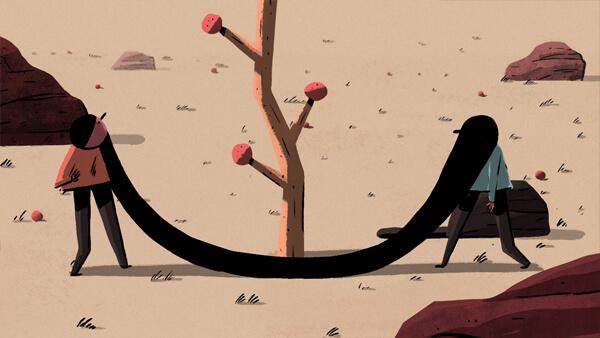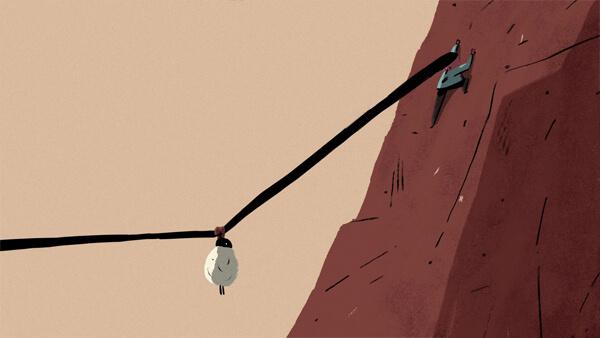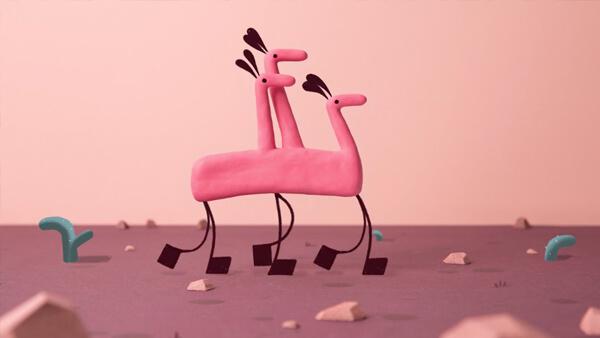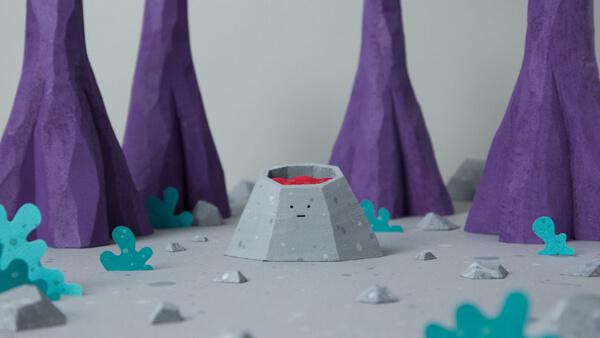Interview with Robert Löbel (LINK/ISLAND)
Robert Löbel is a name that should ring familiar to contemporary animation fans. His HAW Hamburg 2013 graduation film WIND was one of the year’s standouts, amassing 10+ awards during a festival run that included high-tier Official Selections at Annecy, ITFS Stuttgart, OIAF, Anima Mundi, LIAF and GIRAF among many others.
This year Robert has emerged with not one, but two new works that are beginning to make waves of their own. In LINK we see two characters navigate the terrain of a sparsely populated world while being intrinsically connected by their hair. Elsewhere, Robert combines his abilities as a 2D animator with former classmate Max Mörtl’s skill at stop-motion to create the mixed-media world of ISLAND. In anticipation of LINK‘s inclusion in our Skwigly Screening at this year’s Manchester Animation Festival we took the opportunity to catch up with Robert about his intriguing new work.
We last spoke to you about your film Wind back in 2015. Can you tell us what you’ve been up to since then?
I did some freelance work, gave lectures & workshops. I developed one animated short concept for the garbage bin. I made two new shorts LINK and ISLAND. My girlfriend and I got a baby and moved to a crazy expensive new flat that I normally couldn´t afford as an indie filmmaker. Aah, and of course I did my taxes.
How did LINK initially get off the ground, and from where did the fundamental visual concept of the film originate?
First of all I got some funding money, referring to my first short WIND. I had to spend this money in two years, otherwise it was gone, so I thought a lot about film concepts this time. I wanted to do two short films, one a bit longer and mind-cracking and the other short, fast and simple. LINK became the longer one. The initial idea came when I visited my mother on her birthday, I sat at the table together with my grandparents and we totally had nothing to say to each other. We`re a family but totally different characters, we have to see each other at least once a year but no one knows each other for real. That’s when I started to think about these family connections – you never can tear it apart and everyone goes different ways to express their personality, but if something happens to one of them all the other members know about it immediately.

LINK (Dir. Robert Löbel)
Beside this family connection idea I also thought about friends who stayed in our little city where I was going to school. Today when I visit them they mostly have kids and a house and everything. I started thinking of the pros and cons of these different ways of living, because I still feel kinda connected to them as well, but for them I`m more or less a strange outsider now. And maybe we lost the connection we once had to each other.
To make theses connections stronger and more natural I thought it should come directly out of the head, so hair is perfect to bring them closer and it also looks more uncomfortable.
Originally I wanted to do a really rough film, even more rough than it is now, but as it progressed it got more clean. I had the feeling of making it ‘worse’ all the time. It`s pretty hard to recognize if something that’s in your head doesn’t come out the way it should be, but I got used to it during the production. Otherwise the film still wouldn’t be finished today, I guess.
Your animation work often plays around with the laws of physics, what’s the main appeal of this approach as an animator/storyteller?
I like to play around with characters and conflicts that affect their behaviour. I also like to challenge myself with 2D animation. LINK was my second short, I also wanted to experiment a bit with the technique and try to learn more about handling two characters that are not in the same frame but still connected. I was magically drawn to it.
Compared to the desaturated palette of WIND, Link has a somewhat richer use of colour, as well as a freer approach to the line work. What inspired this style shift for the film?
The story tells me what to do. In writing and storyboarding I try not to think too much about the visuals. After the storyboard I got these elements – mountains, trees, fruits, birds, hair. The rest came naturally and, of course, by trial and error.

LINK (Dir. Robert Löbel)
You tend to favour films without dialogue – what are the main benefits of this (or challenges)?
In my concepts at the moment language is not necessary. Dialogue is something different, because gestures, eye contact or making weird noises at each other is dialogue as well.
In your experience does having a film be silent help your work play to international audiences?
I don`t know if it helps…maybe. It makes me happy if everybody in the world can understand the film without subtitles or some foreign language, but I wanna try a film with language soon – it’s on the list.
Another recent film of yours, ISLAND, takes a different approach to its story and visual style. What were the origins of this film and your working relationship with Max (Mörtl, co-director)?
After – or in-between – working on LINK I needed to start my second short for the German funding institute FFA. I calculated everything beforehand and knew that I need to finish LINK fast enough to still have some time to produce the other, smaller film. Again the funding money disappears after two years so I had to be as quick as possible. The problem was everything took longer than expected (as always), plus my baby was born and we had to move in a bigger apartment. The good thing was that I kept my old apartment for some months and used it as a studio. I invited my old study buddy Max Mörtl, who lives now in Munich, to come to Berlin so we could join forces. I also wanted to finally have a team again after working months alone with LINK. In University we basically were an animation duo. We did almost every animation project together and both started to experiment a lot with stop-motion during that time. Max became a professional stop-motion animator and I slid into 2D animation.
In ISLAND we finally wanted to mix our strengths. The idea was to do as many weird characters as we wanted with almost no limits. Characters became animals, animals have to make sounds, so we took an island as our stage. We did some style frames with clay characters and some line drawings over it. With this we asked David Kamp if he wanted to be our sound designer and fortunately he accepted. So we developed the character look, the sounds and beats together directly from the beginning. We did the storyboard, animatic and color tests together. Later we split up a bit – Max built all the sets on his own, while I did the character movements in 2D and some compositing. Max later used my animation clips as guidelines for the stop-motion movements. But there were also characters completely animated in stop-motion or 2D.

ISLAND (Dir. Robert Löbel/Max Mörtl)
Were you working on ISLAND and LINK simultaneously or one after the other (and if the former did that entail any challenges from a production planning/scheduling standpoint)?
Simultaneously. LINK sadly took too long for me to produce, so I had to stop the production in between for ISLAND. After we had to leave my old apartment Max went back to Munich. The film wasn’t 100% finished, so he was nice enough to finish the last stop-motion shots in his home office. During that time I needed to finish my short in the last couple of weeks before the funding institute’s deadline. We had a lot of Skype calls, sending each other stills and sketches from Berlin to Munich.
Although executed in a different medium the film retains a lot of your sensibilities when it comes to environment design. Were there any difficulties when translating this look into a 3D/crafted environment?
Not really. Max is a stop-motion superhero, he can craft everything. We tested and tweaked every environment a couple of hours before shooting. It was a natural process.

ISLAND (Dir. Robert Löbel/Max Mörtl)
ISLAND is composed of a series of vignettes rather than a straightforward narrative thread, per se. How were these visual ideas generated/developed, and was there any specific logical approach to the order in which they appear when it came to the final edit?
We arranged every animal on David Kamp`s beat. After working out the characters, we knew which animal can make a bass sound or a nice cute tone. The beat is the driving force in this short. We tried to build a slow start and a dramatic ending. The order of these animals in the end depends on the beat.
What are you working on now, or next?
At the moment I´m a full time Daddy. I´m in my maternity leave right now. In the evening I try to catch up with my daily mails and doing some freelance jobs, submitting to festival or answering interviews 😉
Festival passholders can catch LINK as part of the Skwigly Screening at Manchester Animation Festival this week (4:10pm, Thursday November 16th at HOME)

